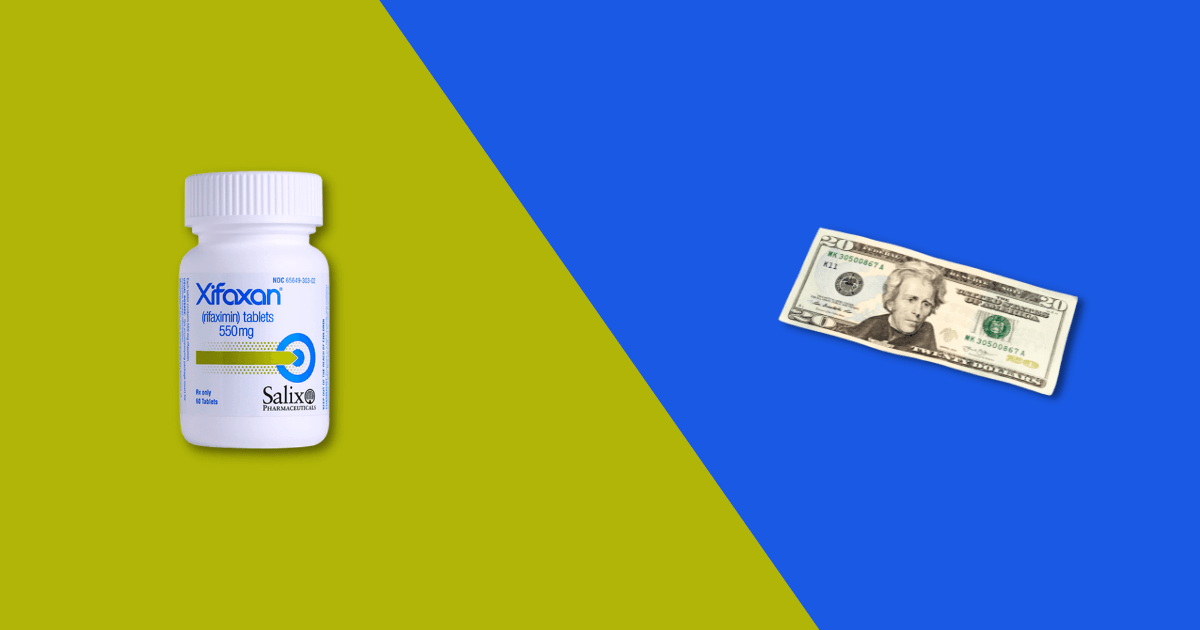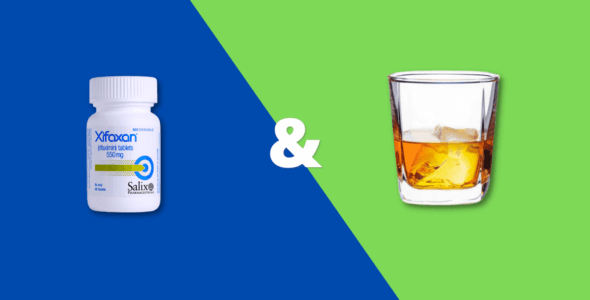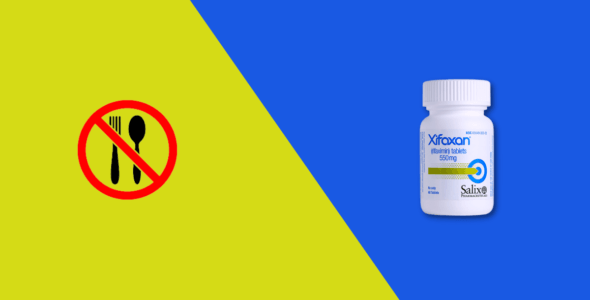Why is Xifaxan so expensive?
Table of contents
Xifaxan is an expensive prescription drug used to treat irritable bowel syndrome with diarrhea (IBS-D) in adults and traveler’s diarrhea. IBS affects around 11% of the global population and only 30% of people who experience symptoms will consult a physician.
Americans pay more for prescription drugs than any other country. There are currently no generic alternatives to Xifaxan. Find out why Xifaxan is so expensive and what options are available to save money on this medication.
What is Xifaxan (rifaximin)?
Xifaxan is an FDA (U.S. Federal and Drug Administration) approved prescription medication used for the treatment of:
- irritable bowel syndrome with diarrhea (IBS-D) in adults
- traveler’s diarrhea caused by Escherichia coli (E. coli) in adults and children who are at least 12 years old
- hepatic encephalopathy by stopping the growth of bacteria that produce toxins and that could potentially worsen liver disease, and lower the risk of a decline in brain function in adults with liver failure
Xifaxan is also used to relieve bloating from medical conditions such as small intestinal bacterial overgrowth (SIBO). Unlike the large intestine (also known as the gut or colon), which has most of your gut bacteria, the small intestine should not contain large amounts of bacteria.
The active ingredient in Xifaxam is rifaximin. Rifaximin is a gastrointestinal-selective antibiotic with a broad spectrum of antimicrobial activity, minimal drug interactions, an excellent safety profile, and negligible impact on the intestinal microbiome.
This medication comes in tablet form for oral administration in the strengths 200mg and 550mg, and can be taken with or without food. Xifaxan is manufactured by Salix Pharmaceuticals.
Xifaxan side effects
The most common side effects of Xifaxan in clinical trials, when used for the treatment of irritable bowel syndrome with diarrhea (IBS-D), are nausea and an increase in liver enzymes. Constipation was observed in only 0.5% of people taking Xifaxan, and nausea was observed in 3% of people taking Xifaxan vs 2% of people taking a placebo.
Other common side effects of rifaximin include swelling in your hands or feet, headache, dizziness, tiredness, or abnormal liver function tests.
With antibiotics like rifaximin, there is a possibility that you could experience diarrhea caused by an overgrowth of bacteria which may cause symptoms that range in severity from mild diarrhea to life-threatening colitis.
If you experience any side effects or possible signs of an allergic reaction while taking Xifaxan, speak with your healthcare provider right away. You are also encouraged to report negative side effects to the FDA. Let your healthcare provider know about all of the other medications, over-the-counter products, and supplements you are taking. To report the side effects of this medication, visit www.fda.gov/medwatch or call 1-800-FDA-1088.
Get your Xifaxan medication for only $49 per month
Get StartedHow much does Xifaxan cost?
The estimated retail price for Xifaxan without insurance is around $315 for a pack of 30x200mg tablets, and up to around $3,000 for a pack of 60x550mg tablets.
Xifaxan cost can vary based on your health insurance coverage for this medication. Contact your insurance broker or pharmacist to find out if your health insurance plan covers Xifaxan under its formulary. You should also find out from your insurance company if there are any deductibles and the copay amount for this medication.
Each insurance plan has its own drug formulary that determines which drugs it will cover. Some insurance plans may have Xifaxan on a higher tier which means that this prescription drug may have to pay a higher coinsurance or copayment.
According to the manufacturer:
- 90% of eligible commercially insured individuals who had prescription drug coverage for Xifaxan paid less than $10 out-of-pocket for their prescription when an eVoucher or copay card was used in 2020.
- 98% of commercially insured individuals have prescription drug coverage for Xifaxan, and more than 70% of these individuals have access to this medication without step therapy.
- 96% of people enrolled in Medicare have coverage for Xifaxan
- Low-income subsidy (LIS) enrollees pay no more than $9.20 per Xifaxan prescription, which is a Medicare Part D benefit.
Why is Xifaxan so expensive?
There are a few reasons why Xifaxan is an expensive prescription drug:
The generic version of Xifaxan is not yet available
Generic Xifaxan is not yet available in the United States. The earliest possible date a generic version could become available is sometime in 2027, which is when the patents are expected to expire. Until then, a generic drug alternative will not be available for this medication.
Typically, generic drugs cost less than brand-name drugs as multiple pharmaceutical manufacturers sell the medication at competitive prices. When there is no generic alternative on the market, there is only one manufacturer that sells the drug.
RELATED: Brand vs generic drugs
Patent law protection
Xifaxan is under patent protection by the United States Patent and Trademark Office (USPTO) covering the composition of matter and the use of Xifaxan listed in the approvals granted by the U.S. Food and Drug Administration (FDA). This allows the drug’s manufacturer, Salix Pharmaceuticals, to have exclusive rights to sell Xifaxan. The FDA approval process for a new drug is lengthy and expensive, so pharmaceutical companies typically recoup their research and development costs by charging higher prices for their brand-name drugs.
Typically, most drug patents expire 20 years after the initial application date. For medications that are used in the treatment of rare diseases that affect 200,000 or fewer people in the United States, the Orphan Drug Act provides pharmaceutical companies an additional seven years of patent protection. Pharmaceutical companies can also apply for an extension on the patent protection by reformulating the medication, changing how to drug is administrated, or simplifying the dose, which is commonly known as a “new formulation” or “new use” patent. The extension of the patent will delay the availability of generic alternatives for the medication.
After the patent expires, other drug companies can start applying for FDA approval to market generic alternatives of the medication, which are typically much less expensive than brand-name drugs because the generic manufacturers do not have the same costs associated with bringing a new drug to market. The first generic of Xifaxan could be available as soon as 2027 which is when the patents expire.
Unregulated prescription drug prices in the United States
Unlike most other developed countries, the United States does not have any laws regulating the price of prescription drugs. The pharmaceutical companies are solely responsible for setting the prices of prescription drugs. The cost of prescription drugs is determined by many factors, including:
- The cost of research and development
- The price of the raw materials needed to make the medication
- The demand for the drug
- Marketing and advertising costs
- Profit margins
- The cost of research and development
It typically costs a pharmaceutical company billions of dollars to bring a new drug to market. The cost of research and development is often recouped by charging higher prices for brand-name drugs.
A study by RAND shows that medication prices in the United States are on average 2.56 times higher than in other OECD countries.
How do I save on Xifaxan?
Xifaxan is an expensive drug, especially for those who do not have any prescription drug coverage for this medication. Fortunately, there are several options that could possibly help you save money:
- Xifaxan Savings Card – the manufacturer offers a savings card to help save money. If eligible, commercially insured individuals who had coverage for Xifaxan could pay less than $10 for their medication when a copay card or eVoucher is applied.
- Patient assistance programs – find out if you are eligible for enrollment into a Xifaxan patient assistance program.
- Ask your prescribing doctor for free samples of Xifaxan – many pharmaceutical companies provide healthcare providers with free samples to provide to their patients in order to help them get started on the medication.
- Get medical advice from your healthcare professional and find out if there are any alternative medicines for your medical condition – ask your prescribing doctor if there are any lower-cost alternatives to Xifaxan.
- Shop around for the lowest price at multiple mail-order pharmacies – the price for Xifaxan can vary by pharmacy and may not be the cheapest at your local pharmacy, so you should always check pricing at multiple pharmacies to find the lowest possible price.
- Xifaxan coupons – find out if there is a Xifaxan manufacturer coupon that can help you save money on this medication.
- Get help from Medicaid – find out if you are eligible for a state Medicaid plan that may cover the cost of Xifaxan.
Medically reviewed
A medical professional has reviewed this article.


Jamie Winn, PharmD
Jamie Winn, PharmD
Dr. Jamie Winn received his Doctor of Pharmacy in 2002 from the University of South Carolina College of Pharmacy, Columbia, SC. Jamie is a medical reviewer for NiceRx.



